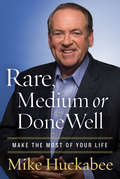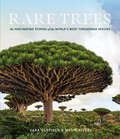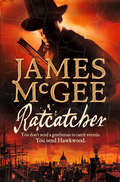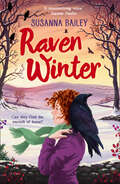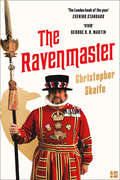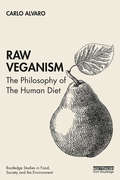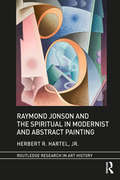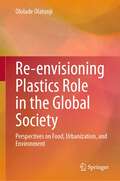- Table View
- List View
Rare Birds in Britain and Ireland: (1976) (Poyser Monographs #82)
by J.T.R. Sharrock E. M SharrockDr J. T. R. Sharrock is uniquely placed to write about the rare birds of Britain and Ireland. He is a member of all three bodies which adjudicate on such records - honorary secretary of the British Ornithologists' Union's Records Committee and a member of both the British Birds Rarities Committee and the Irish Records Panel. He is already the author of a companion book which deals with a selection of the commoner rarities, Scarce Migrant Birds in Britain and Ireland (see back of this jacket for details). In this new, much fuller book the enormous task of collation of over 8000 records and their visual display as maps and histograms was carried out by Mrs E. M. Sharrock. The textual and visual analysis deals with 221 different species. Between them, the authors present a complete picture of rare birds in Britain and Ireland: * HOW MANY are seen? * WHEN do they occur? * HOW regularly do they come? * WHERE are they seen? There are line drawings of all 221 species by well-known bird artists: Robert Gillmor, P. J. Grant, R. A. Richardson, D. I. M. Wallace and lan Willis. Jacket design by Robert Gillmor
Rare, Medium, or Done Well: Make the Most of Your Life
by Mike HuckabeeAre you wondering how to make a difference in today's culture that will benefit future generations? Former Governor Mike Huckabee shares how to live a life that will continue to be felt by those who carry your legacy forward. Whether in politics, family, education, or business, what matters most is leaving a legacy for future generations. Rare, Medium or Done Well emphasizes the importance of understanding where we've been, where we are now, and how both determine where we're going. Mike asserts, "A person who has no standard to live by other than the culture of the moment is a person whose principles might as well come from the latest public opinion polls."
Rare Trees: The Fascinating Stories of the World's Most Threatened Species
by Sara Oldfield Malin RiversFilled with more than 300 color photographs, Rare Trees is a stunning survey of the world's most threatened trees.
Rarity (Population and Community Biology Series #13)
by K.J. GastonTo say you are writing about rarity is to invite two kinds of response. Either one provokes a discussion of what rarity is, or some comment on the complex ity of the subject. The objective of this book is to explore the nature of rarity, its complexity if you like, from one particular perspective on what rarity is. Primarily, it is an opportunity to review, to synthesize, and to question. The book is an attempt to draw together a vast body of literature, to extract from it some general principles, and to raise question marks over areas the founda tions of which appear to be either absent or crumbling. A perusal of prefaces suggests that they often dwell as long upon what a book is not about, as upon what it does concern. True to such a tradition, I should state that this is specifically not a book about conservation, although in some quarters anything about rarity is viewed as something about conser vation. Nor does it contain more than a passing reference to the undoubtedly important issues of the role of genetics in rarity. Examples have been drawn from a wide variety of taxa. They are, nonethe less, somewhat depauperate in cases from marine systems. In part this bias results from the unevenness of my familiarity with the literature, in part it perhaps also reflects differences in the questions asked and approaches to the study of communities and assemblages in terrestrial and marine systems.
Rat Island: Predators in Paradise and the World's Greatest Wildlife Rescue
by William StolzenburgRat Island rises from the icy gray waters of the Bering Sea, a mass of volcanic rock covered with tundra, midway between Alaska and Siberia. Once a remote sanctuary for enormous flocks of seabirds, the island gained a new name when shipwrecked rats colonized, savaging the nesting birds by the thousands. Now, on this and hundreds of other remote islands around the world, a massive - and massively controversial - wildlife rescue mission is under way.Islands, making up just 3 percent of Earth's landmass, harbor more than half of its endangered species. These fragile ecosystems, home to unique species that evolved in peaceful isolation, have been catastrophically disrupted by mainland predators: rats, cats, goats, and pigs ferried by humans to islands around the globe. To save these endangered islanders, academic ecologists have teamed up with professional hunters and semiretired poachers in a radical act of conservation now bent on annihilating the invaders. Sharpshooters are sniping at goat herds from helicopters. Biological SWAT teams are blanketing mountainous isles with rat poison. Rat Island reveals a little-known and much-debated side of today's conservation movement, founded on a cruel-to-be-kind philosophy.Touring exotic locales with a ragtag group of environmental fighters, William Stolzenburg delivers both perilous adventure and intimate portraits of human, beast, hero, and villain. And amid manifold threats to life on Earth, he reveals a new reason to hope.
Ratcatcher: Ratcatcher, Resurrectionist, Rapscallion
by James McGeeRegency London is vividly brought to life in this extraordinary page-turner, the first in a series of historical thrillers featuring Bow Street Runner Matthew Hawkwood – a dangerous, sexy and fascinating hero.
Raumklimatechnik: Grundlagen (VDI-Buch)
by Hermann Rietschel Horst EsdornMit der 16. Auflage des RIETSCHEL in der Bearbeitung von Professor Esdorn ist in ausgezeichneter Qualität ein bedeutendes Standardwerk wieder verfügbar. Das vierbändige Gesamtwerk umfaßt das vollständige Wissen für Studium und Praxis. Band 1 enthält die für die Heiz- und Raumlufttechnik erforderlichen wissenschaftlichen Grundlagen, während die Bände 2-4 anwendungstechnisch orientiert sind.
The Ravaged Paradise: Environmental History of Colonial Darjeeling Himalaya (1835–1947)
by Dipanwita DasguptaThis book makes a systematic attempt to explore the environmental history of Darjeeling during the British colonial period (1835-1947), which profoundly transformed the environment of Darjeeling by introducing commercial control over the natural resources. After the foundation of Darjeeling as the hill station for the low-income groups of British administration living in Bengal and Burma, the place was transformed into a social, recreational and commercial centre for the British authorities. The railway construction boom, introduction of tea plantation, the growth of a commercial market for timber and increasing demands for fuel and building materials depleted the forest cover. The less explored regions of Darjeeling attracted the adventure-thirsty Britons. A series of investigations were made on the marketable products, the condition of roads, and quality of soil of these regions. The ethnographic, geological, botanical and zoological study of the Darjeeling was started by the colonial officials in the nineteenth century. In the early stage of expansion of colonialism in Asia, Africa, Australia and South America, the European colonizers faced numerous problems in dealing with the untouched nature. The accumulation of the knowledge of surrounding regions and proper management of the labour became essential for the colonial authority for transformation of the existing environment of the densely forested tropical colonies. Taylor and Francis does not sell or distribute the print editions of this book in India, Pakistan, Nepal, Bhutan, Bangladesh and Sri Lanka.
The Ravaged Paradise: Environmental History of Colonial Darjeeling Himalaya (1835–1947)
by Dipanwita DasguptaThis book makes a systematic attempt to explore the environmental history of Darjeeling during the British colonial period (1835-1947), which profoundly transformed the environment of Darjeeling by introducing commercial control over the natural resources. After the foundation of Darjeeling as the hill station for the low-income groups of British administration living in Bengal and Burma, the place was transformed into a social, recreational and commercial centre for the British authorities. The railway construction boom, introduction of tea plantation, the growth of a commercial market for timber and increasing demands for fuel and building materials depleted the forest cover. The less explored regions of Darjeeling attracted the adventure-thirsty Britons. A series of investigations were made on the marketable products, the condition of roads, and quality of soil of these regions. The ethnographic, geological, botanical and zoological study of the Darjeeling was started by the colonial officials in the nineteenth century. In the early stage of expansion of colonialism in Asia, Africa, Australia and South America, the European colonizers faced numerous problems in dealing with the untouched nature. The accumulation of the knowledge of surrounding regions and proper management of the labour became essential for the colonial authority for transformation of the existing environment of the densely forested tropical colonies. Taylor and Francis does not sell or distribute the print editions of this book in India, Pakistan, Nepal, Bhutan, Bangladesh and Sri Lanka.
Raven Winter
by Susanna BaileyThe brand new novel from the critically-acclaimed author of Snow Foal and Otters' Moon. Perfect for fans of Jacqueline Wilson and Gill Lewis.
The Ravenmaster: My Life With The Ravens At The Tower Of London
by Christopher Skaife'Packed with insight and anecdote, his story brings the Tower ravens to vivid life, each bird with a personality of its own. I've been fortunate enough to tour the Tower and meet the ravens a few times in years past; after reading this book, I cannot wait to go back' George R. R. Martin
The Raven's Nest
by Sarah Thomas'Fascinating' - Robert Macfarlane, author of The Old Ways'Truly a thing of wonder' - Kerri ní Dochartaigh, author of Thin Places'Lyrical [and] thoughtful' - Cal Flyn, author of Islands of AbandonmentVisiting Iceland as an anthropologist and film-maker in 2008, Sarah Thomas is spellbound by its otherworldly landscape. An immediate love for this country and for Bjarni, a man she meets there, turns a week-long stay into a transformative half-decade, one which radically alters Sarah's understanding of herself and of the living world.She embarks on a relationship not only with Bjarni, but with the light, the language, and the old wooden house they make their home. She finds a place where the light of the midwinter full moon reflected by snow can be brighter than daylight, where the earth can tremor at any time, and where the word for echo - bergmál - translates as 'the language of the mountain'. In the midst of crisis both personal and planetary, as her marriage falls apart, Sarah finds inspiration in the artistry of a raven's nest: a home which persists through breaking and reweaving - over and over.Written in beautifully vivid prose The Raven's Nest is a profoundly moving meditation on place, identity and how we might live in an era of environmental disruption.
The Raven's Song
by Zana Fraillon Bren MacDibbleThe Raven’s Song alternates between the stories of Phoenix, who lives in a near-future world impacted by climate change and a devastating pandemic; and Shelby, one hundred years in the future in a post-pandemic, post-pollution, post-city world where each community is exactly three hundred and fifty people sustainably subsisting on seven hundred hectares. The story of a world that is beginning to fall apart, and a chance to see it all put back together, The Raven’s Song is a vision of hope for the future, seen through the eyes of the young people who will fight for it.
The Raven's Song
by Zana Fraillon Bren MacDibbleThe Raven’s Song alternates between the stories of Phoenix, who lives in a near-future world impacted by climate change and a devastating pandemic; and Shelby, one hundred years in the future in a post-pandemic, post-pollution, post-city world where each community is exactly three hundred and fifty people sustainably subsisting on seven hundred hectares. The story of a world that is beginning to fall apart, and a chance to see it all put back together, The Raven’s Song is a vision of hope for the future, seen through the eyes of the young people who will fight for it.
Ravine Lands: Greening for Livelihood and Environmental Security
by Jagdish Chander Dagar Anil Kumar SinghThis book, the only one of its kind on ravine lands, reflects the significant advances made over the past two decades in our understanding of gully erosion, its controlling factors, and various aspects of gully erosion. It also addresses central research gaps and unanswered questions, which include historical studies on gully erosion to better understand the different stages of their formation; appropriate measuring techniques for monitoring or assessing the geological and hydrological parameters and processes involved in gully development; interaction of hydrological and other soil degradation processes; ecology and biodiversity of fragile ravines; impact of climate and environmental changes on soil erosion processes; development of effective and reliable gully erosion models; effective gully prevention and control measures; watershed-based management options; and ravine rehabilitation policies. The present book is a highly timely publication and deals with various aspects of ravine ecology and rehabilitation of degraded lands, particularly with the aid of biological approaches. As such, it offers a valuable guide for all scientists working in the fields of soil conservation / rehabilitation and agroforestry, students, environmentalists, educationists, and policymakers. More importantly, it focuses on the rehabilitation of one of the world’s most degraded and fragile ecosystems, ensuring the livelihoods of resource-poor farmers and landless families living in harsh ecologies that are more vulnerable to climate change.
Ravished by Beauty: The Surprising Legacy of Reformed Spirituality
by Belden C. LaneIn this novel exploration of Reformed spirituality, Belden C. Lane uncovers a "green theology" that celebrates a community of jubilant creatures of all languages and species. Lane reveals an ecologically sensitive Calvin who spoke of himself as ''ravished'' by the earth's beauty. He speaks of Puritans who fostered a ''lusty'' spirituality in which Christ figured as a lover who encouraged meditation on the wonders of creation. He presents a Jonathan Edwards who urged a sensuous ''enjoyment'' of God's beauty as the only real way of knowing God. Lane argues for the ''double irony'' of Reformed spirituality, showing that Calvinists who often seem prudish and proper are in fact a people of passionate desire. Similarly, Reformed Christians who appear totally focused on divine transcendence turn out at times to be closet nature mystics, exulting in God's glory everywhere. Lane also demonstrates, however, that a spirituality of desire can be derailed, ending in sexual excess and pantheism. Ecologically, holy longing can be redirected from a contemplation of God's splendor in the earth's beauty to a craving for land itself, resulting in disastrous misuse of its resources. Between the major chapters of the book are engaging personal essays drawn from the author's own love of nature as a Reformed Christian, and providing a thoughtful discussion of contemporary issues of species diversity and the honoring of an earth community.
Ravished by Beauty: The Surprising Legacy of Reformed Spirituality
by Belden C. LaneIn this novel exploration of Reformed spirituality, Belden C. Lane uncovers a "green theology" that celebrates a community of jubilant creatures of all languages and species. Lane reveals an ecologically sensitive Calvin who spoke of himself as ''ravished'' by the earth's beauty. He speaks of Puritans who fostered a ''lusty'' spirituality in which Christ figured as a lover who encouraged meditation on the wonders of creation. He presents a Jonathan Edwards who urged a sensuous ''enjoyment'' of God's beauty as the only real way of knowing God. Lane argues for the ''double irony'' of Reformed spirituality, showing that Calvinists who often seem prudish and proper are in fact a people of passionate desire. Similarly, Reformed Christians who appear totally focused on divine transcendence turn out at times to be closet nature mystics, exulting in God's glory everywhere. Lane also demonstrates, however, that a spirituality of desire can be derailed, ending in sexual excess and pantheism. Ecologically, holy longing can be redirected from a contemplation of God's splendor in the earth's beauty to a craving for land itself, resulting in disastrous misuse of its resources. Between the major chapters of the book are engaging personal essays drawn from the author's own love of nature as a Reformed Christian, and providing a thoughtful discussion of contemporary issues of species diversity and the honoring of an earth community.
Raw Veganism: The Philosophy of The Human Diet (Routledge Studies in Food, Society and the Environment)
by Carlo AlvaroHuman beings are getting fatter and sicker. As we question what we eat and why we eat it, this book argues that living well involves consuming a raw vegan diet. With eating healthfully and eating ethically being simpler said than done, this book argues that the best solution to health, environmental, and ethical problems concerning animals is raw veganism—the human diet. The human diet is what humans are naturally designed to eat, and that is, a raw vegan diet of fruit, tender leafy greens, and occasionally nuts and seeds. While veganism raises challenging questions over the ethics of consuming animal products, while also considering the environmental impact of the agriculture industry, raw veganism goes a step further and argues that consuming cooked food is also detrimental to our health and the environment. Cooking foods allows us to eat food that is not otherwise fit for human consumption and in an age that promotes eating foods in ‘moderation’ and having ‘balanced’ diets, this raises the question of why we are eating foods that should only be consumed in moderation at all, as moderation clearly implies they aren’t good for us. In addition, from an environmental perspective, the use of stoves, ovens and microwaves for cooking contributes significantly to energy consumption and cooking in general generates excessive waste of food and resources. Thus, this book maintains that living well and living a noble life, that is, good physical and moral health, requires consuming a raw vegan diet. Exploring the scientific and philosophical aspects of raw veganism, this novel book is essential reading for all interested in promoting ethical, healthful, and sustainable diets.
Raw Veganism: The Philosophy of The Human Diet (Routledge Studies in Food, Society and the Environment)
by Carlo AlvaroHuman beings are getting fatter and sicker. As we question what we eat and why we eat it, this book argues that living well involves consuming a raw vegan diet. With eating healthfully and eating ethically being simpler said than done, this book argues that the best solution to health, environmental, and ethical problems concerning animals is raw veganism—the human diet. The human diet is what humans are naturally designed to eat, and that is, a raw vegan diet of fruit, tender leafy greens, and occasionally nuts and seeds. While veganism raises challenging questions over the ethics of consuming animal products, while also considering the environmental impact of the agriculture industry, raw veganism goes a step further and argues that consuming cooked food is also detrimental to our health and the environment. Cooking foods allows us to eat food that is not otherwise fit for human consumption and in an age that promotes eating foods in ‘moderation’ and having ‘balanced’ diets, this raises the question of why we are eating foods that should only be consumed in moderation at all, as moderation clearly implies they aren’t good for us. In addition, from an environmental perspective, the use of stoves, ovens and microwaves for cooking contributes significantly to energy consumption and cooking in general generates excessive waste of food and resources. Thus, this book maintains that living well and living a noble life, that is, good physical and moral health, requires consuming a raw vegan diet. Exploring the scientific and philosophical aspects of raw veganism, this novel book is essential reading for all interested in promoting ethical, healthful, and sustainable diets.
Rawls and the Environmental Crisis (Routledge Explorations in Environmental Studies)
by Dominic WelburnThe liberal political theorist John Rawls, despite remaining largely silent on ‘green concerns’, was writing during a time of increasing awareness that the ecological stability of the earth is being compromised by human activity. Rawls’s reluctance to engage with such concerns, however, has not stopped several scholars attempting to ‘extend’, or ‘expand’, his works to incorporate this newfound fear for the ecosystems that support human life. But why Rawls? What is to be gained from developing the ideas of a theorist whose primary aim was to establish a system of justice for contemporaneous, rational, and reasonable citizens of a liberal polity? This research monograph offers a critical consideration of the contextual framework within John Rawls’s Political Liberalism and considers its compatibility with the conceptual process of ‘greening’. Rawls and the Environmental Crisis argues that Rawls’s perceived neutrality on green concerns is representative of a widespread societal indifference to environmental degradation and describes the plurality of methodological and ethical approaches undertaken by green political theorists in analyzing the contribution Rawls’s theory makes to environmental concerns. Addressing a series of key debates within contemporary political philosophy regarding a wider frustration with liberal theory in general, Rawls and the Environmental Crisis will be of great interest to researchers in contemporary political philosophy, environmental ethics, green political theory, stewardship theory, and those interested in renewing existing conceptions of deliberative democracy.
Rawls and the Environmental Crisis (Routledge Explorations in Environmental Studies)
by Dominic WelburnThe liberal political theorist John Rawls, despite remaining largely silent on ‘green concerns’, was writing during a time of increasing awareness that the ecological stability of the earth is being compromised by human activity. Rawls’s reluctance to engage with such concerns, however, has not stopped several scholars attempting to ‘extend’, or ‘expand’, his works to incorporate this newfound fear for the ecosystems that support human life. But why Rawls? What is to be gained from developing the ideas of a theorist whose primary aim was to establish a system of justice for contemporaneous, rational, and reasonable citizens of a liberal polity? This research monograph offers a critical consideration of the contextual framework within John Rawls’s Political Liberalism and considers its compatibility with the conceptual process of ‘greening’. Rawls and the Environmental Crisis argues that Rawls’s perceived neutrality on green concerns is representative of a widespread societal indifference to environmental degradation and describes the plurality of methodological and ethical approaches undertaken by green political theorists in analyzing the contribution Rawls’s theory makes to environmental concerns. Addressing a series of key debates within contemporary political philosophy regarding a wider frustration with liberal theory in general, Rawls and the Environmental Crisis will be of great interest to researchers in contemporary political philosophy, environmental ethics, green political theory, stewardship theory, and those interested in renewing existing conceptions of deliberative democracy.
Ray Mears Outdoor Survival Handbook: A Guide to the Materials in the Wild and How To Use them for Food, Warmth, Shelter and Navigation
by Ray MearsRay Mears' Outdoor Survival Handbook is a book of discovery, explaining the everyday skills you need to live in and enjoy the natural world. Season by season, this unique, fully illustrated guide describes the resources and materials available in the wild and how to use them. Whether you want to spend a day, a week or a month out of doors, Ray Mears' Outdoor Survival Handbook will help you enjoy it to the full. Packed with practical tips, insights into nature and respect for traditional knowledge, this is a book for families, groups and individual hikers and climbers - for everyone who enjoys outdoor life.
Raymond Jonson and the Spiritual in Modernist and Abstract Painting (Routledge Research in Art History)
by Herbert R. Hartel, Jr.This is the most thorough and detailed monograph on the artwork of Raymond Jonson. He is one of many artists of the first half of the twentieth-century who demonstrate the richness and diversity of an under-appreciated period in the history of American art. Visualizing the spiritual was one of the fundamental goals of early abstract painting in the years before and during World War I. Artists turned to alternative spirituality, the occult, and mysticism, believing that the pure use of line, shape, color, light and texture could convey spiritual insight. Jonson was steadfastly dedicated to this goal for most of his career and he always believed that modernist and abstract styles were the most effective and compelling means of achieving it.
Raymond Jonson and the Spiritual in Modernist and Abstract Painting (Routledge Research in Art History)
by Herbert R. Hartel, Jr.This is the most thorough and detailed monograph on the artwork of Raymond Jonson. He is one of many artists of the first half of the twentieth-century who demonstrate the richness and diversity of an under-appreciated period in the history of American art. Visualizing the spiritual was one of the fundamental goals of early abstract painting in the years before and during World War I. Artists turned to alternative spirituality, the occult, and mysticism, believing that the pure use of line, shape, color, light and texture could convey spiritual insight. Jonson was steadfastly dedicated to this goal for most of his career and he always believed that modernist and abstract styles were the most effective and compelling means of achieving it.
Re-envisioning Plastics Role in the Global Society: Perspectives on Food, Urbanization, and Environment
by Ololade OlatunjiThis book covers the challenges and opportunities presented by plastics in the modern era and sheds light on the complex interplay of technology, environment, and socio-economic dynamics. With a thorough exploration of the history, uses, and potential of plastics, the book reviews the impact of plastics beyond single-use plastics, and critiques multiple long-term plastic applications that are significant for food security, water resource management, ecological conservation/restoration, and sustainable urbanization. It also explores frameworks for achieving a more sustainable plastic economy aligned with sustainable development goals. This book comprises 13 chapters, commencing with a critical assessment of plastics in the context of sustainable development and global society. It proceeds with a historical overview of plastics' evolution, showcasing pivotal milestones and innovations in modern industry and daily life. Subsequent chapters delve into diverse topics: the intricate relationships between plastics, food security, and sustainable urbanization; plastics' impact on water safety, management, distribution, and conservation; their potential as an alternative energy source; and their innovative applications in sustainable transportation and energy generation. Emphasis is placed on plastics' role in waste reduction and recycling, as well as the latest sustainable alternatives like biodegradable and recyclable materials. In the book's final sections, readers will learn about green buildings and climate-resilient cities constructed using innovative plastic materials, and plastics' significance in space exploration. The book concludes with a forward-looking perspective on plastics' future, accompanied by recommendations for a more sustainable coexistence between society and these versatile materials. This book is a valuable resource for researchers, policymakers, industry professionals, and concerned citizens seeking to navigate the intricate landscape of plastics, their environmental implications, and their potential for sustainable development.

